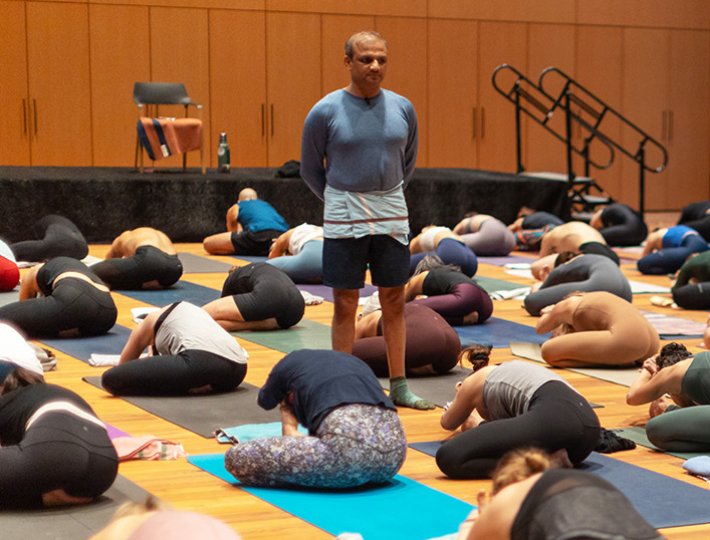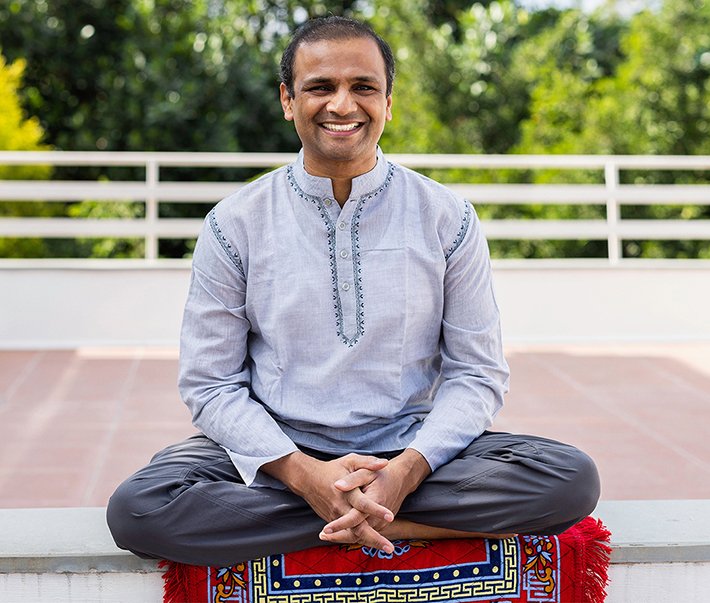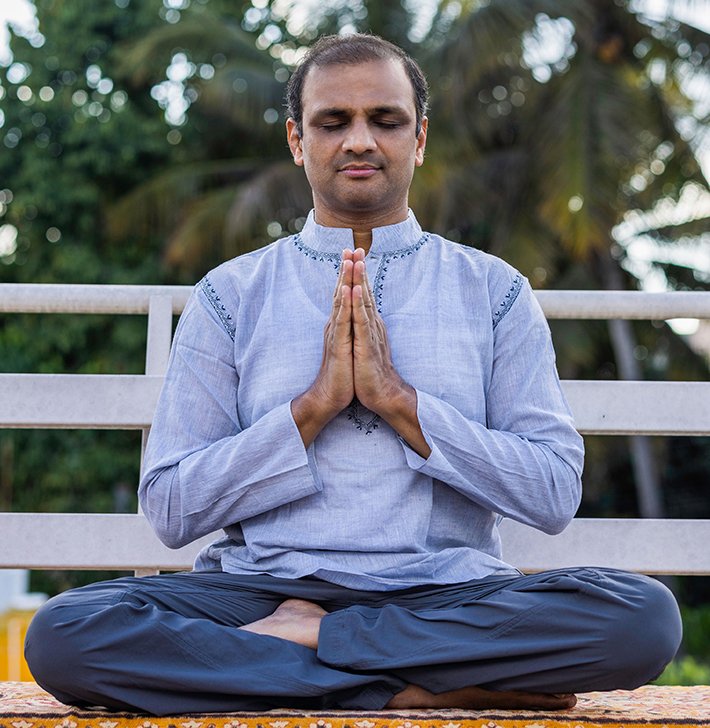Stress isn’t just an adult problem. Teens are also feeling the pressure these days and, in some cases, more than their older counterparts. A 2013 survey called “Stress in America” from the American Psychological Association found that some adolescents reported higher stress levels during the school year than adults in the same month. Extreme stress in teens—who may be mirroring surrounding burnt-out adults—has high consequences. Constantly feeling overwhelmed, depressed or sad, and fatigued or tired can impact behavior resulting in lack of sleep or exercise and poor eating. Picking up stress-related bad habits early may lead to chronic illness, such as heart disease and obesity, and ultimately a shorter lifespan.
Dire as this sounds, don’t fret: There are some solutions to help everyone, especially kids, calm down. The David Lynch Foundation’s Quiet Time (QT) program, for example, is already changing lives. The national initiative, which started in San Fransisco in 2007, takes a science-backed approach to lowering stress in at-risk middle school and high school students and faculty. To promote relaxation and help clear the mind, QT site directors and their staff teach schools how to meditate—specifically transcendental meditation (TM)—for 15 minutes twice a day (morning and afternoon) in the classroom. Students who do not receive consent from parents to learn TM or simply prefer not to participate are asked to read in silence or sit quietly during these two short periods.
Related: What Is Transcendental Meditation?
Just 30 minutes a day is proving to make a big difference. A new study published in the July edition of Contemporary School Psychology observed 141 ninth graders who participated in QT—whether that meant meditating, reading or sitting quietly—at their school for six months and compared them to 53 ninth graders at another school, where QT was not in place. Students who took part in QT, compared to those who did not, reported significantly reduced anxiety and improved class attendance, school performance, and resilience. They also claimed to sleep better, and feel happier and more self-confident.
It’s no secret that meditation is good for you. In fact, there are more than 380 peer-reviewed scientific studies that document how a regular TM practice can improve health and well-being. Meditation in general (not just TM) can also change your brain, according to Harvard University researchers.
Neuroscientist Sara Lazar, Ph.D., along with her colleagues, found that as little as eight weeks of daily practice can enlarge four different areas of the brain: the posterior cingulate, left hippocampus, temporo parietal junction, and the brain stem. These regions influence mind-wandering, self-relevance, learning, cognition, memory, emotional regulation, empathy, and compassion.
The amygdala—where anxiety, fear, and stress live—also changed in size, however, rather than get bigger, it shrunk (grey matter density decreased) through the mindfulness-based stress reduction (MBSR) program.
This particular QT study, however, is among the few looking at how the act of meditating or simply sitting comfortably in silence for a few minutes a day can impact urban youth and education. “For me, the most important take-away was finding out that there is something worth studying here,” says lead study author Staci Wendt, Ph.D., a research associate at WestEd, a San Francisco-based nonprofit research agency designed to improve education for children, youth, and adults. Wendt admits that the study did not take into account whether QT students meditated, read, or rested during each session. Further research is needed to better understand meditation’s role in the promising results. Psychologists and neuroscientists from Oxford University and University College London are working on this: Researchers are currently recruiting 7,000 kids and teens, ages 11 to 16 from 76 secondary schools, to participate in an unprecedented seven-year-study on the effects on mindfulness meditation on mental health.
Pioneers of the QT program can take an educated guess why the results of this study were so positive. “The human body is really intelligent. It naturally knows how to heal itself through balance. Studies have found that the quality of breath during TM is deeper than deep sleep. So when our bodies get this deep rest, automatically our bodies’ natural intelligence takes over and begins to release stress and minimize its impact on the body,” says site director Donielle Freeberg, who brought QT to Los Angeles in 2010 and is now overseeing the program in New York City.
Related: The Good and Bad Effects of Stress in Children
The youngest pupil of QT is 10 years old. “That’s when their nervous systems and brains are most ready and mature to have this experience,” she explains. High school-aged kids may have a slight advantage over middle schoolers. “[High schoolers] are at an age where they can get the value of the tool on a deeper level and carry it with them in their life, outside of meditation and school,” says Freeberg, who remembers one particular sophomore whom she first met when she brought QT to an LA school four years ago.
“She was a teenage mom who was taking care of her little brothers (there wasn’t a lot parental presence at home) and, in her words, she said, ‘I felt like I was a dumb person and I couldn’t do my work.’ After a few months of learning TM, she said she felt like she could actually focus on her schoolwork. She took meditation very seriously, doing it every day. When she graduated, she ended up getting a full scholarship, including housing for her and her daughter, at Berkley,” Freeberg says proudly.
The David Lynch Foundation has launched QT in 20 schools across the country (namely public and charter schools in San Francisco, Los Angeles, Detroit, DC, NYC, and Chicago) and are serving nearly 5,000 faculty and staff this year. The program has also been funded in other countries, including Brazil, Ghana, Israel, Kenya, Nepal, Peru, South Africa, Uganda, and Vietnam. Outside of QT, other unrelated organizations, like the Sonima Foundation, a nonprofit started by Sonima.com founder Sonia Jones, offer stress-reducing, mindfulness curriculum to students and seeing similar results.
“Programs like QT give students the opportunity to sit in a quiet space and work on how to cope with stress and increase resiliency. This is incredibly important because those are foundational practices that can lead to increases in academic outcomes that we’re all looking to better understand,” says Michael Corke, Ph.D., research director at the Sonima Foundation, which serves over 43,000 students, grades K-12 across 81 schools in California, Florida, New York, and Texas. “If a student is not comfortable in their learning environment then they are not as likely to learn.”
Similar to the in-progress UK study on teens and meditation mentioned above, the Sonima Foundation is working with Stanford University researchers to investigate whether mindfulness practices can help young kids suffering from post-traumatic stress disorder. The four-year project led by Victor Carrion, M.D., will ask 800 third- and fifth-graders from California to participate in 45-minute wellness classes, including yoga and coping skills, two to three days a week. The theory is that mindfulness may help improve their attention span in school and better regulate their emotions.
Though these mindfulness programs are growing, it may be a good while before you see one come to a school near you. Rather than wait, start building in your own version of QT at home with your family. “Rest is key,” Freeberg says. Take the time to go for an easy breezy walk in nature with your kids. Or promote family reading time maybe after dinner, where you all silently read in the living room for 5 minutes with the intention of slowly working your way up to 15 minutes over time. As you build this practice into your daily routine, try to encourage your kids (and yourself!) to read or sit quietly before or after breakfast and dinner. “Do whatever is restful to you [and your family] to help your bodies release stress and reset itself,” Freeberg adds.








Comments (0)